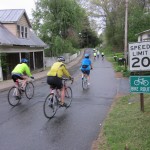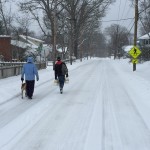
Streets were for people in the throes of the storm.
Mother Nature can be one of the greatest tests of a Complete Streets policy. The snowstorm that hit the eastern United States in January 2016 led to numerous blasts on social media about blocked pedestrian access, sidewalks heaped with snow, and a general lack of consideration after the storm for the mobility of people who walk. All road users were not equal during this weather event.
Snow can be the great equalizer on our streets. During the throes of the storm people walked in the streets of West Asheville’s business district along Haywood Road (US 19-Business) . The motorists that were on the roads were slow, deliberate in their movements, and incredibly respectful of the space of people who had to walk in the streets because sidewalks were impassable.
All that ended once the roads were cleared. In Asheville, the snow ended early Saturday and by Saturday afternoon the major roads were cleared of snow and ice, which led to motorists returning to somewhat normal speeds.
I saw many businesses in my neighborhood clearing their sidewalks in the hours after the storm ended. I thanked them.
What happened with the management of snow that fell on the streets was appalling. And it seemed to be a common occurrence in almost every city in the eastern United States.
The public agencies responsible for snow management in public right-of-way have a thankless job. I understand the urgency to plow major roads during and immediately after the storm. Emergency services access is–and should be–a top priority.
But plowing snow is something that must be done with care in urban environments. Sidewalks, crosswalks, and curb ramps are not snow storage areas. Yet that’s exactly how they were treated in the 1 to 4 days after the storm (I’m writing this on day 4).
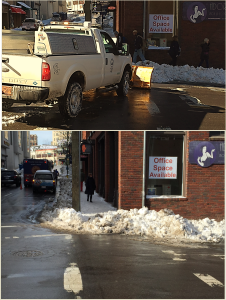
This plow operator deliberately moved snow from parking lanes to a crosswalk. He then pushed the snow against the curb ramp, blocking pedestrian access.
I witnessed snow plows purposely depositing large chunks of ice and snow onto sidewalks that were already cleared by property owners. I heard public agencies threaten property owners with fines for not clearing snow from sidewalks while those same public agencies neglected to clear their own sidewalks. I saw plow operators moving snow from on-street parking spaces downtown to then block crosswalks and curb ramps. I saw trucks salting decks of parking garages while plows were blocking pedestrian access to those parking garages.
People accessing the downtown transit center were blocked by the snow plowed from the transit center, forcing them to walk in the street to get the bus station. This was more than 72 hours after the last flakes fell.
Despite all the moaning and complaining by people who walk (I was not afraid to tweet to my city and state DOT for these acts), there were examples on social media of municipalities doing a great job of respecting pedestrians. I walked more 30 miles of streets in Asheville in the three days after the storm with that in mind. In that, I found many lessons for cities and DOTs to consider when this happens next time.
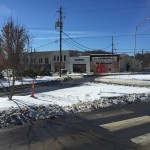
At a roundabout the plow is forced to operate at a lower speed. This led to smaller mounds of snow blocking pedestrian access. The smaller mound melted faster than snow mounds on high speed routes.
1. Plow with care: Plow operators that move at a slower speed can keep much of the snow from being heaped upon the sidewalk. On Louisiana Avenue in West Asheville (a DOT-managed road that was plowed by city crews), there was a small mound of snow encroaching on the first foot or so of the sidewalk, but the lower speed of the plow that cleared the street kept the snow from being blasted onto the entire sidewalk. Much of the snow was still within the road prism and mounded against the curb. This allowed pedestrians to move behind these small mounds with at least 3 feet of clear space to operate without having to climb over chunks of snow and ice. I also saw this occur at the roundabout in the River Arts District. Just as roundabouts slow motorists, the plow operators had to lower their speeds. The results was less mounding of snow in the pedestrian access route. Even without clearing of the snow, the mounds melted long before other mounded plowed across curb ramps on higher speed routes.
2. Define priority routes for people who walk: Sylva, NC (pop. 2,600) sent its crews out with small snow machines to clear snow from priority pedestrian routes within and accessing downtown. This is a great, manageable, economic approach that shows a community values more than just the movement of cars. Just as cities designate priority streets for snow plowing, they should designate priority routes for maintaining access for pedestrians. This can include directing plow operators to move at slower speeds to decrease encroachment of snow on the sidewalks along these routes. It could mean partnerships with businesses, organizations, or private plow operators to clear the sidewalks after street plows heap snow upon them.
3. Follow the plows with smaller machines: The purposeful blocking of crosswalks and curb ramps was my biggest pet peeve in the wake of the storm. This is where I witnessed city plows clearing parking spaces (while cities touted free parking in garages to keep cars off the streets) and purposely blocking access to the sidewalk. One operator plowed the snow from parking spaces directly into the crosswalk, then did a u-turn in a downtown intersection to push that snow in front of the curb ramp. It left a three foot pile of snow directly in the walkway of onlooking pedestrians.
Hoboken, NJ (pop. 53,000) did the opposite. The City tweeted an image of their crews coming behind snow plows to clear ice and snow from crosswalks and curb ramps. The plow operators were allowed to do their job with efficiency, but they recognized the barriers created by that. Therefore, crews came behind the plows with smaller machinery to clear the mounds of snow that blocked in-street pedestrian routes. This snow can be deposited in nearby large parking lots (with agreement from property owners) or in unused areas of public right-of-way, such as medians (I saw this all the time when I worked in Idaho), landscaped areas around interchanges or in DOT/public works maintenance yards or surplus properties.
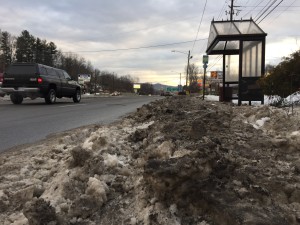
Plows made conditions worse at bus stops. When service resumed the chunks of ice and snow deposited there by plows created miserable conditions.
4. Clear the pathway from bus stops to the street: City streets and city transit services are co-dependent upon one another. While property owners are responsible for clearing sidewalks, most bus stops are located within 50 feet of an intersection or a curb ramp. At minimum, cities should clear the route from the ramp to the bus stop to provide basic access. It doesn’t fully solve the problem, but it does give a place for the bus lift to operate and provides a space for those who take transit to wait at a location respectful of their transportation needs. Cities know which routes have the highest ridership and which stops have the most boardings/alightings. Start there and work your way through the system.
5. Change policies to reflect reality: Most property owners, especially businesses, were able to clear the snow that fell from the sky with just a shovel. Public agencies then placed an additional cost burden on these businesses by deliberately using sidewalks for the storage of the snow that fell on the streets. This caused property owners to have to use heavier equipment to clear the snow, typically done by private plow operators. I do not believe the ordinances requiring property owners to clear snow were developed under the auspices of giving public agencies free reign to heap snow back onto the sidewalks. This is unfair to property owners who diligently cleared their sidewalks who then see plows depositing large chunks of snow and ice back on the sidewalks.
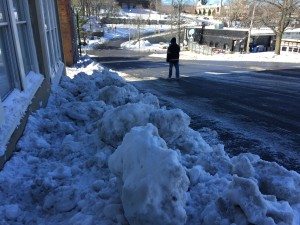
Is it fair to threaten property owners with a fine after public agencies deposit snow boulders on their sidewalks?
Policies should change to require property owners to clear the initial snowfall, but public agencies that deliberately use sidewalks for snow storage should then be responsible for their own actions. I think it would cause plow operators to manage the snow with greater care and everyone would benefit.
6. Dedicated a % of resources to ensuring pedestrian access: The overt emphasis on plowing streets for motorists upset me greatly. After all, our governor and other leaders were very deliberate in telling us to stay off the roads for the two days after the storm. I heeded their advice and walked, a lot. Their agency’s action ignored the fact that people respected this advice and chose to not drive. It made me think how we could determine the proper percentage of resources that could be devoted to snow management for people who walk versus people who drive.
Census data reveals approximately 10% of households in Asheville (roughly 3,500 residences) have no access to a vehicle. There’s a starting point. What if 10% of the resources–personnel hours, salt, equipment–was devoted to non-motorist snow management? This would fund practices like those in Hoboken, and ensure the clearance of bus stops and priority pedestrian routes in those areas where the most people move on foot. The 10% commitment would be put in motion at the same time on-street plowing operations commenced. I think this would make a noticeable difference.
We can do better. I hope this gives agencies an idea on how they can do it.






